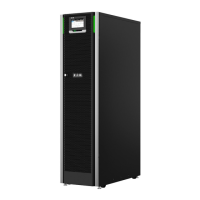12. TB3, not used
13. Serial COM port RS-232
14. MiniSlot 2
15. TB4, EPO
16. TB5, relay output
2.3.2 Battery system installation
If installing a customer-supplied battery system, install the battery system according to the
battery and battery system manufacturer’s instructions and all the applicable national
codes and regulations.
For the battery specification, refer to the Eaton 93PS UPS 8-40 kW User’s and Installation
Guide.
2.3.3 Battery trip wiring
The 93PS 8-40 kW UPS units are always equipped with an internal battery breaker, which
affects only the UPS internal batteries (except for the C model, where the internal battery
breaker can be used for external batteries). The external battery breaker is a crucial part of
the external battery cabinet or rack and must be placed in it. With the external battery
breaker, signal cabling is important.
Both internal and external battery breakers can be tripped (switched off) by energizing its
shunt trip coil. The shunt trip coils of external battery breakers are energized (controlled)
through connectors TB20 and TB21 (TB21 available only in the 30-40 kW UPS with
separate battery configuration). The default voltage of the shunt trip coil is 24 Vdc.
Battery trip wiring is shown in illustration 9. The parts are as follows:
2.3.4 Installing UPS external battery cabinet and battery power cabling
For instructions on how to install the external battery cabinet and battery power cabling,
see the Eaton 93PS UPS 8-40 kW User’s and Installation Guide and the instruction manual
provided with the external battery cabinet. Earth the external battery cabinet / customer-
supplied battery system to the PE terminal 17.
2.3.5 Installing a remote EPO switch
EPO is connected to the UPS's top front panel, on connector EPO. The connections of the
EPO switch are shown in illustration 10.
2.3.6 Installing interface connections
For information on installing interface connections, refer to the Eaton 93PS UPS 8-40 kW
User’s and Installation Guide.

